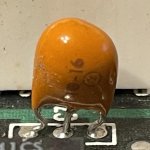1200XL M.U.L.E.
Experienced Member
- Joined
- May 9, 2021
- Messages
- 84
While I wait for my 3.5" floppy drive for my Epson Equity 1+ to be delivered, I decided to buy an IBM 5150 on eBay. It was a low priced "barnyard find" and I understood there may be risks ... but I couldn't anticipate this one.
The computer came with several cards including a floppy controller, a HD controller, a monochrome graphic card, and a CHRONOGRAPH RAMPORT card. I took all the cards except the floppy controller (so I can boot). There was a Seagate ST-225 hard drive and I removed it also. I installed the CGA card from my Epson and connected my monitor to it all. After checking the DIP switches, I turned on the computer and to my happy surprise the computer booted! That means the power supply, motherboard, and floppy drive are generally OK. Unfortunately, I don't have a XT keyboard and I learned the hard way that AT keyboards don't work here.
Anyways ...
Now I try to run the HD controller and the Seagate 225. Oh, not good! The fan in the power supply barely turns and I hear buzzing sounds from the power supply. The hard drive is groaning. I quickly turn off the computer. The HD and the HD controller are out.
Next I try the CHRONOGRAPH RAMPORT card. Ohh ... ohhh ... ohhhhhh! If I could turn back time I would.
I inserted that card into a slot and turned on the computer. The fan spun up but made a slightly different sound. Nothing appeared on the screen. Suddenly, a capacitor in the upper left corner of the card popped and all the magic smoke inside of it escaped! The power shut itself off and I quickly turned off the computer.
I removed the RAMPORT card but now the computer won't boot. Sometimes the power supply fan spins up, sometimes it doesn't. If I remove all the cards then the power supply fan will always spin up. I swap out CGA card for the monochrome card and the fan spins back up. I add the floppy controller back in and the fan still spins. Connecting the floppy drive back kills the fan.
Oh, I felt so bad! What happened? What did I blow out? Can I fix it? I look at the board and I see nothing (yet).
Then I see it after much card swapping.

I blew up a capacitor!!

What is this C7 capacitor? I'm OK with soldering and can mechanically replace this but what is it? The back of the neighboring capacitor says this.

"10-16"
What is this three-legged device? They are all over the motherboard?
Is there anything else I could have broke by plugging the RAMPORT card in?
Any and all help and guidance would be appreciated here.
Thank you!!
The computer came with several cards including a floppy controller, a HD controller, a monochrome graphic card, and a CHRONOGRAPH RAMPORT card. I took all the cards except the floppy controller (so I can boot). There was a Seagate ST-225 hard drive and I removed it also. I installed the CGA card from my Epson and connected my monitor to it all. After checking the DIP switches, I turned on the computer and to my happy surprise the computer booted! That means the power supply, motherboard, and floppy drive are generally OK. Unfortunately, I don't have a XT keyboard and I learned the hard way that AT keyboards don't work here.
Anyways ...
Now I try to run the HD controller and the Seagate 225. Oh, not good! The fan in the power supply barely turns and I hear buzzing sounds from the power supply. The hard drive is groaning. I quickly turn off the computer. The HD and the HD controller are out.
Next I try the CHRONOGRAPH RAMPORT card. Ohh ... ohhh ... ohhhhhh! If I could turn back time I would.
I inserted that card into a slot and turned on the computer. The fan spun up but made a slightly different sound. Nothing appeared on the screen. Suddenly, a capacitor in the upper left corner of the card popped and all the magic smoke inside of it escaped! The power shut itself off and I quickly turned off the computer.
I removed the RAMPORT card but now the computer won't boot. Sometimes the power supply fan spins up, sometimes it doesn't. If I remove all the cards then the power supply fan will always spin up. I swap out CGA card for the monochrome card and the fan spins back up. I add the floppy controller back in and the fan still spins. Connecting the floppy drive back kills the fan.
Oh, I felt so bad! What happened? What did I blow out? Can I fix it? I look at the board and I see nothing (yet).
Then I see it after much card swapping.

I blew up a capacitor!!
What is this C7 capacitor? I'm OK with soldering and can mechanically replace this but what is it? The back of the neighboring capacitor says this.

"10-16"
What is this three-legged device? They are all over the motherboard?
Is there anything else I could have broke by plugging the RAMPORT card in?
Any and all help and guidance would be appreciated here.
Thank you!!
